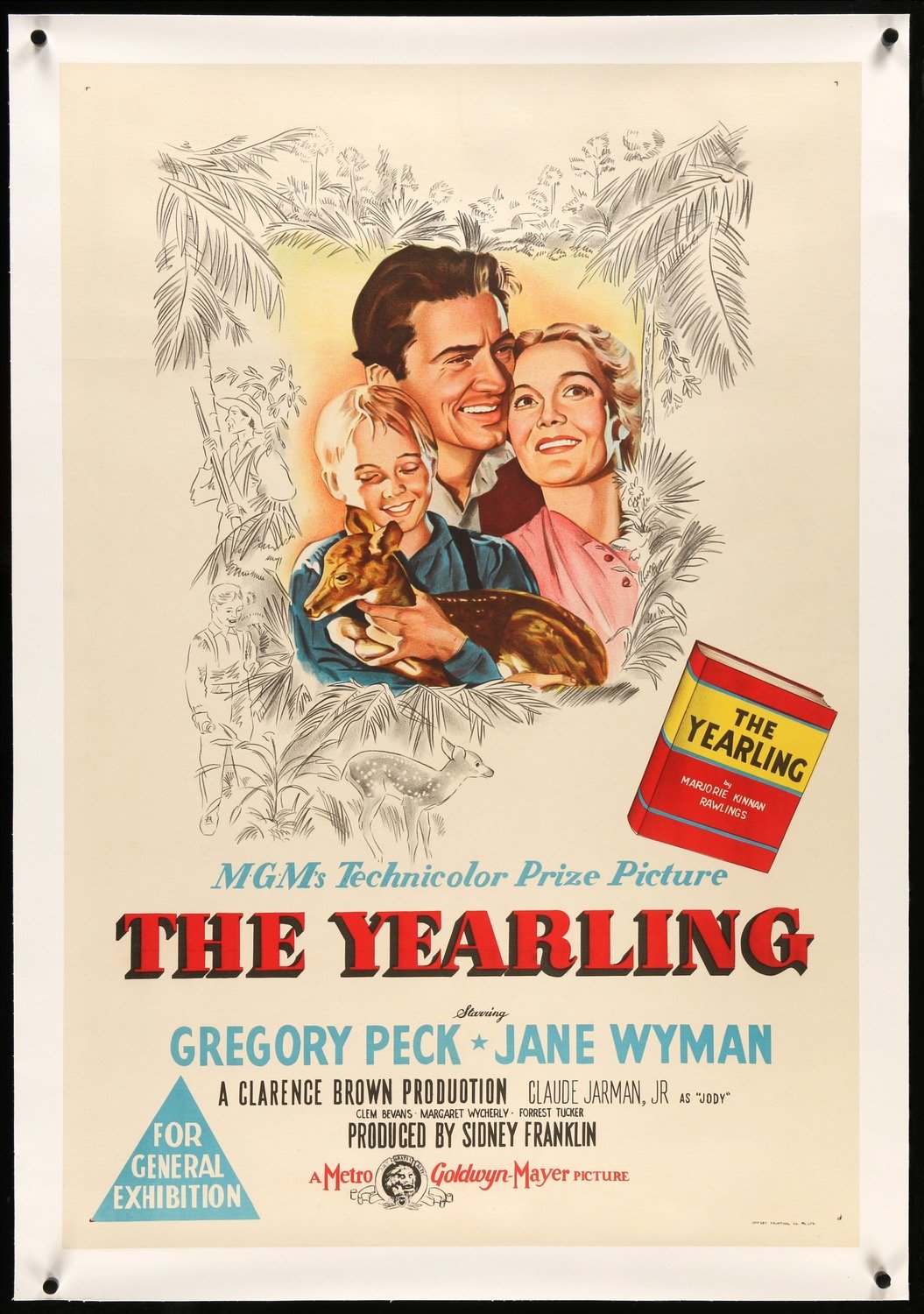A boy’s love for a pet fawn risks the prosperity of a backwoods family living in the wilds of post-Civil War north Florida.
Forty years had largely dimmed my memory since last seeing The Yearling, but a recent viewing was something of a revelation.
Remembered was the pet fawn which continued to jump over higher and higher fences, erected to protect newly planted corn. And, too, somehow as vivid as ever was the young boy of the story running and jumping through the forest with a herd of deer accompanied on the soundtrack by the music of Mendelssohn.
The movie is a decent, caring screen transference of the Marjorie Kinnan Rawlings story, a beautiful, in some ways sentimental film. Beautiful as well is the three-strip Technicolor photography of Charles Rosher which captures the equally beautiful scenery and won one of the film’s two Oscars.
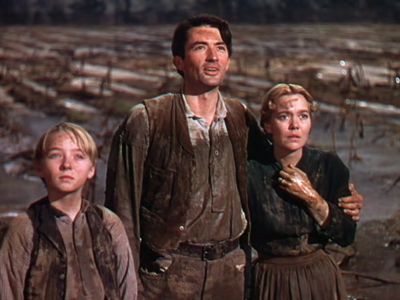 Partly filmed in Florida’s Juniper Prairie Wilderness Park in Ocala National Forest, many of the landscape scenes were shot from a distance with the actors moving across the bottom of the screen and, above, the tall pine and cypress trees, the sky and clouds.
Partly filmed in Florida’s Juniper Prairie Wilderness Park in Ocala National Forest, many of the landscape scenes were shot from a distance with the actors moving across the bottom of the screen and, above, the tall pine and cypress trees, the sky and clouds.
When young Jody Baxter is told he has to put down his pet fawn because it continually eats the family’s budding crops, it’s a real acting tour de force for twelve-year-old Claude Jarman, Jr. in his screen debut. Although Gregory Peck, who plays his father Penny, complained that “the boy cried too much,” young Jarman is the heart of the film. He’s especially effective when, still crying, he screams his hatred of his parents after he finally kills the fawn.
A young thirteen-year-old boy, Fodderwing (Donn Gift), at a farm which the Baxters often visit was crippled when he tried to fly. One night in Fodderwing’s tree house the two boys have a long, thoughtful talk—the kind more mature children have, unbeknown to their parents. Can’t even remotely imagine this being filmed today. Gift is quite good, sad and pathetic. His character later dies—more tears from Jarman! It’s then that his dad (Chill Wills) gives the fawn its name, Flag.
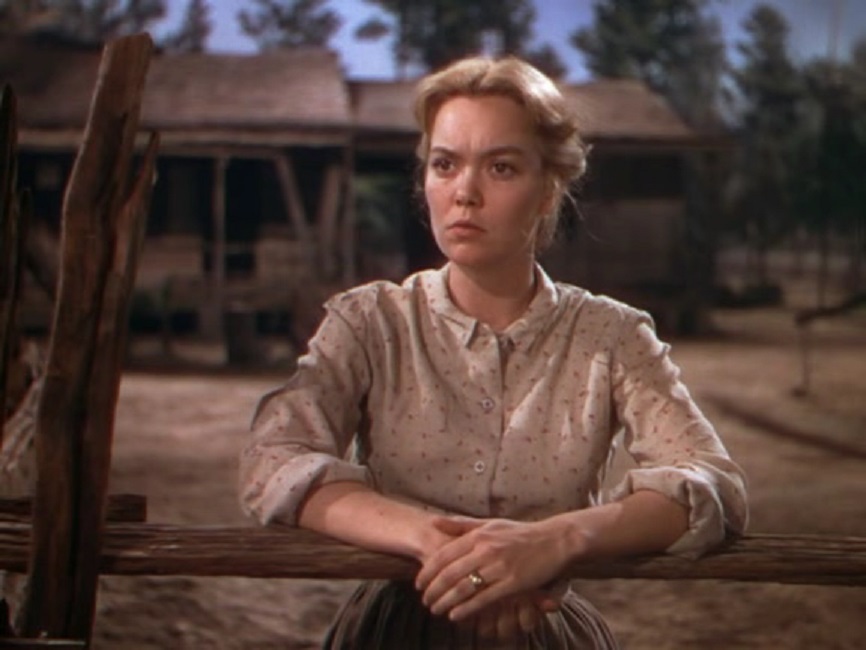 Jane Wyman plays the hard, uptight mother—and quite convincingly, so much so that some viewers might dislike her. She appears harsh because, deep down, she fears losing this only remaining child after losing so many before.
Jane Wyman plays the hard, uptight mother—and quite convincingly, so much so that some viewers might dislike her. She appears harsh because, deep down, she fears losing this only remaining child after losing so many before.
Other cast members, in largely small roles, include Forrest Tucker, Henry Travers, June Lockhart (her ninety-fifth birthday in June), Clem Bevans and Margaret Wycherly as another rustic type—also a “ma” in Sergeant York (1941) and White Heat (1949).
There are some surprisingly effective scenes: Penny and Jody chase (unsuccessfully) a black bear which had raided the chicken coop, with two dogs in pursuit (superbly shot). Penny receives a rattlesnake bite and Jody must run for help. A big storm, and being Florida, more like a hurricane. Penny uses reverse psychology to jettison the third dog which ran from the bear.
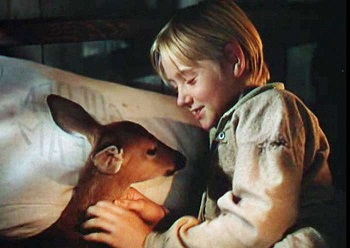
Penny needs a new rifle (it first misfires, then explodes in his face during the bear hunt) and he knows Lem (Tucker) has one. On a visit, he holds this dog in his lap, “To keep him,” he says, “out of the paws of them bloodhounds” of Lem’s, and “I done told you, the dog is worthless.”
Lem feels that any dog which attacked that bear without receiving any wounds—Penny allows him to assume much—must be pretty good and he insists on a trade, his rifle for the dog. Penny plays his game to the last: “You gotta promise not to beat me after you hunted him.”
It’s tempting to draw parallels—not always justified, perhaps—between the relationship of Penny and his son Jody and that of Atticus Finch (Peck) and his daughter Scout (Mary Badham) in To Kill a Mockingbird, made sixteen years later.
The scene where P
enny sits on Jody’s bed and explains the heartbreak of his mother losing several children in infancy can, by a stretch of the imagination, compare with Atticus sitting on Scout’s bed telling her how, one day, a pearl necklace and a ring “that belonged to your mother” will be hers.
In the climax of The Yearling, Jody runs away after having to finish off Flag when his mother only wounds the fawn. When he finally returns home after being rescued in a floating dugout canoe by a riverboat captain, Penny explains the vicissitudes of life: “You’ve seen how things go in the world of men. Every man wants life to be a fine thing and easy. Well, it is fine, son, powerful fine. But it ain’t easy.”
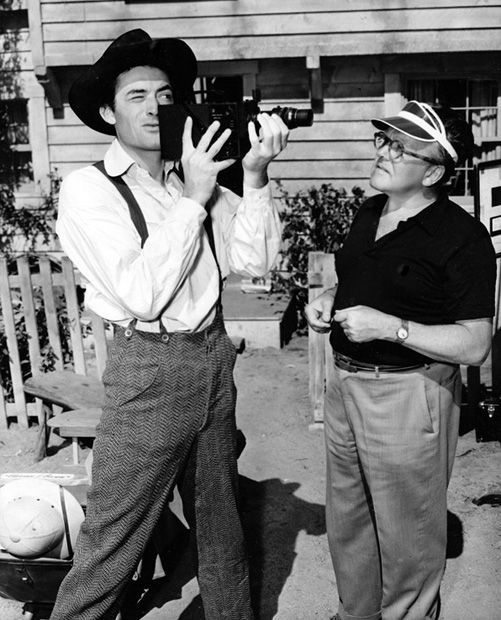
Comparable, in Mockingbird, Atticus explains to Scout the nature of the racism that has arisen over his defending Tom Robinson, an African-American. “Ther
e are some things,” he begins, “you’re not old enough to understand just yet. . . . [I]f I didn’t [defend Robinson], I couldn’t hold my head up in town. I couldn’t even tell you or Jem not to do something again.”
From the bits and pieces of memory, while I did remember the use of the scherzo from Mendelssohn’s A Midsummer Night’s Dream incidental music for the scene with Jody and the deer, I had forgotten that the rest of the score is arrangements (by Herbert Stothart) of music from Frederick Delius, who had spent time in Florida managing a plantation. The music includes bits from the Florida Suite, Koanga and Appalachia.
Additional Oscar nominations were for picture, Peck, direction and editing. The second win besides Color Cinematography was for Color Art-Set Set Decoration. Jarman was awarded Outstanding Child Actor of 1946.
[embedyt] https://www.youtube.com/watch?v=Es3J3nOahnE [/embedyt]
